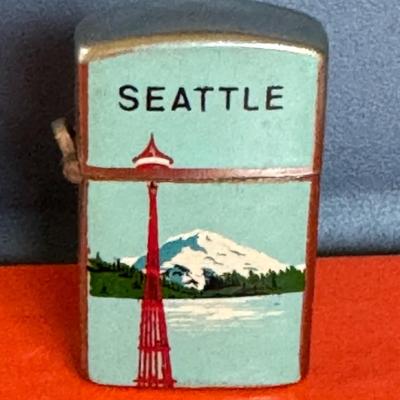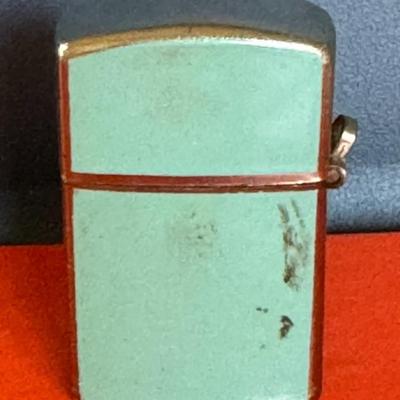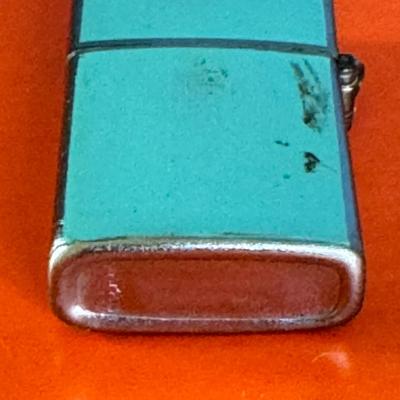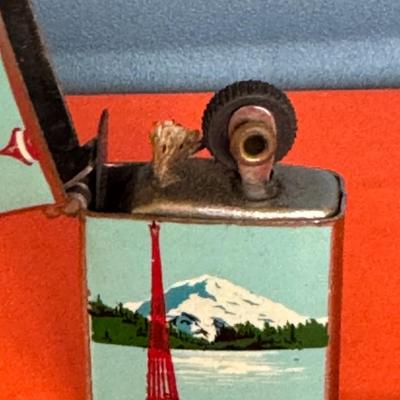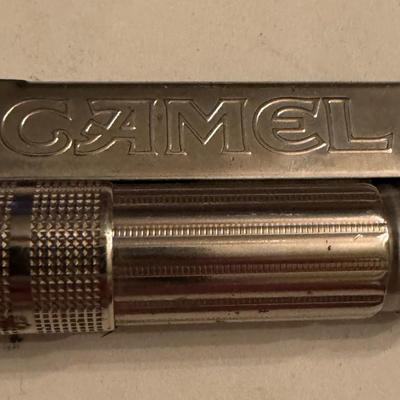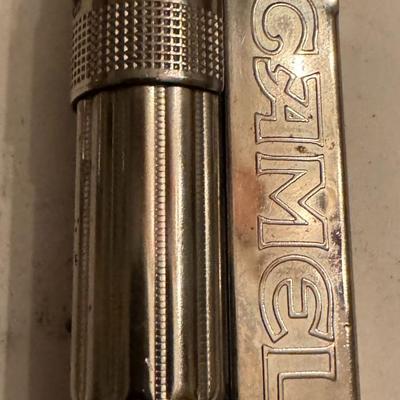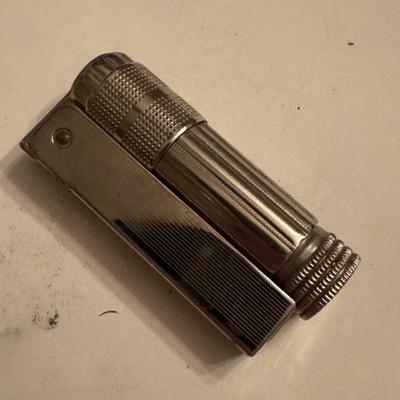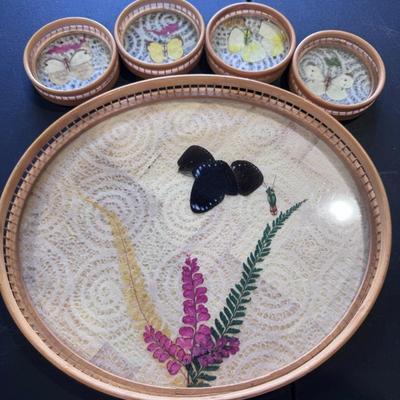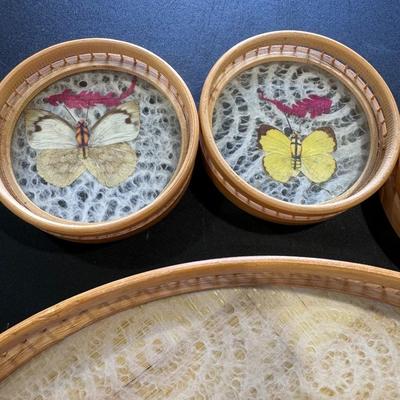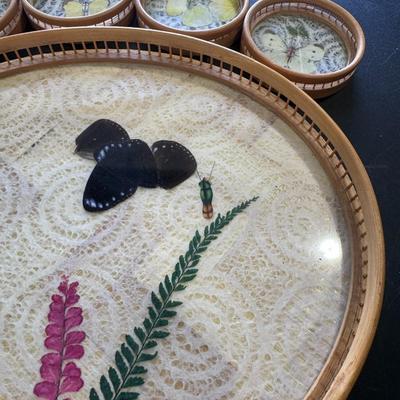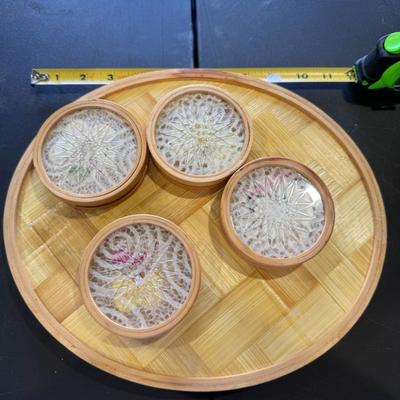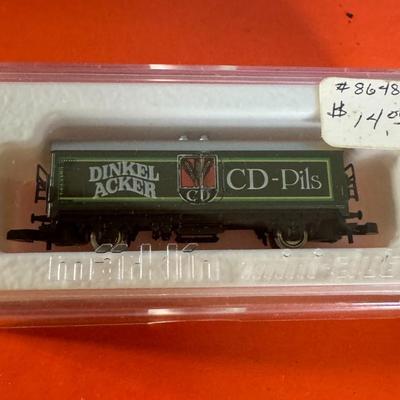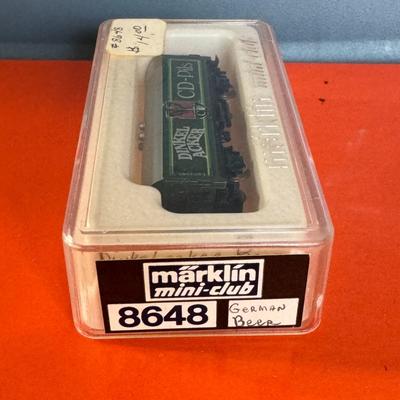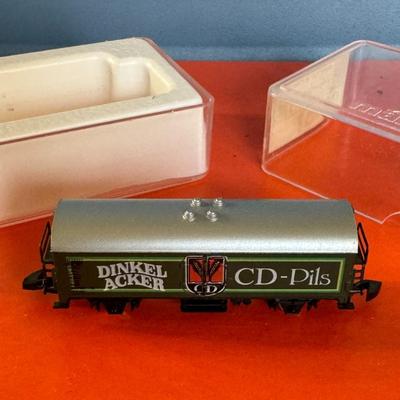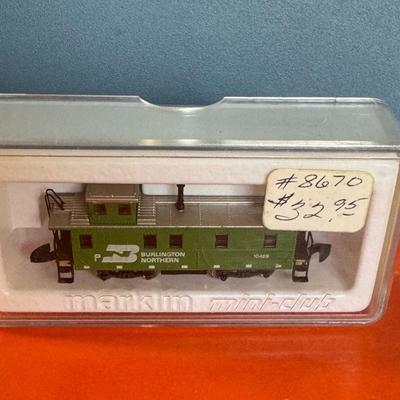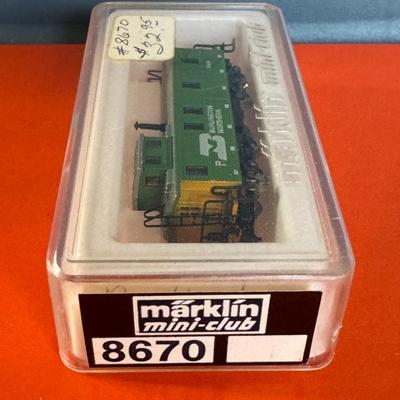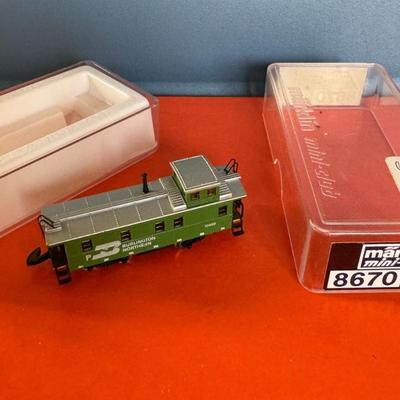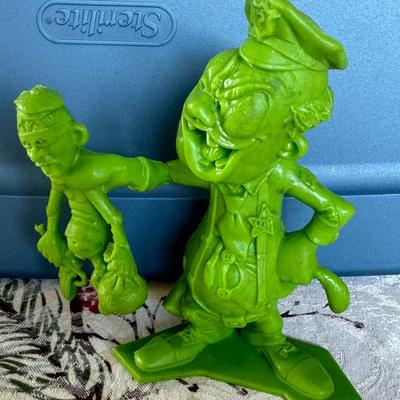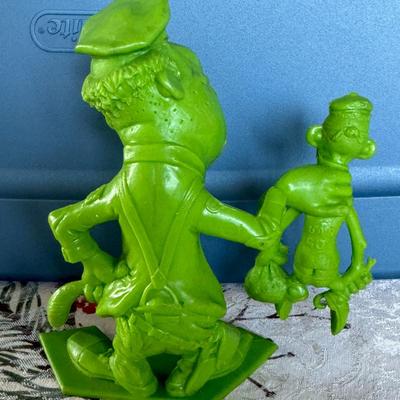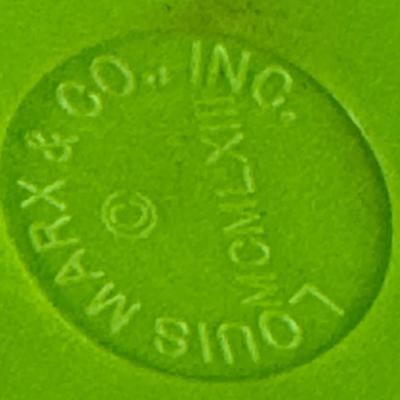-
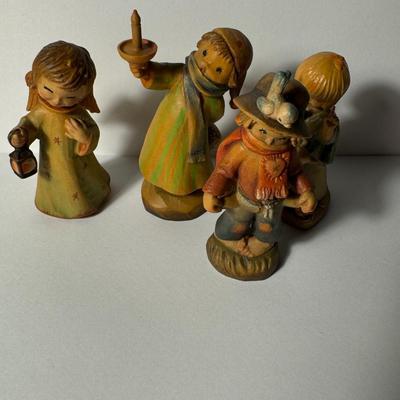
The image shows a collection of four wooden figurines. These vintage, hand-carved, and hand-painted figures, made by the Italian company Anri. One figurine depicts a child holding a lantern. Two figurines portray individuals with scarves, and one of them is holding what appears to be a candle. Another figurine shows a person wearing a hat and holding a stick or a similar object. The Anri figurines are known for their delicate details and charming designs. They are carved from high-quality woods such as maple, alpine pine, lime, ash, and pear, and are hand-painted using special transparent oil colors that reveal the beauty of the wood grain. 601 / 1369 -
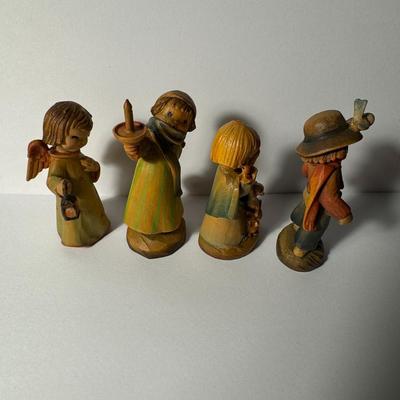
The image shows a collection of four wooden figurines. These vintage, hand-carved, and hand-painted figures, made by the Italian company Anri. One figurine depicts a child holding a lantern. Two figurines portray individuals with scarves, and one of them is holding what appears to be a candle. Another figurine shows a person wearing a hat and holding a stick or a similar object. The Anri figurines are known for their delicate details and charming designs. They are carved from high-quality woods such as maple, alpine pine, lime, ash, and pear, and are hand-painted using special transparent oil colors that reveal the beauty of the wood grain. 602 / 1369 -
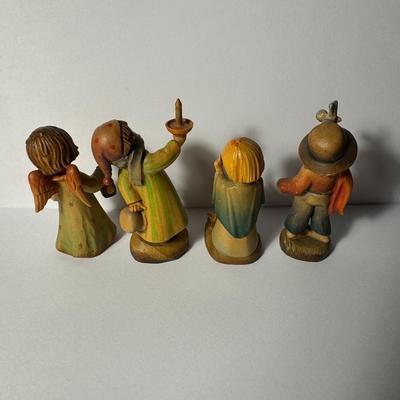
The image shows a collection of four wooden figurines. These vintage, hand-carved, and hand-painted figures, made by the Italian company Anri. One figurine depicts a child holding a lantern. Two figurines portray individuals with scarves, and one of them is holding what appears to be a candle. Another figurine shows a person wearing a hat and holding a stick or a similar object. The Anri figurines are known for their delicate details and charming designs. They are carved from high-quality woods such as maple, alpine pine, lime, ash, and pear, and are hand-painted using special transparent oil colors that reveal the beauty of the wood grain. 603 / 1369 -
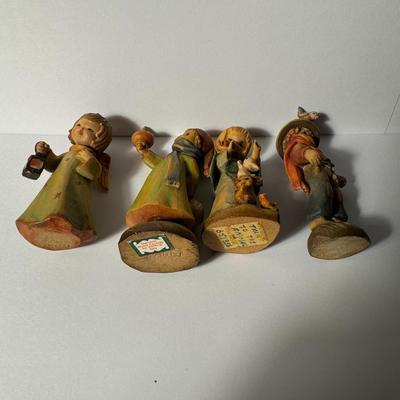
The image shows a collection of four wooden figurines. These vintage, hand-carved, and hand-painted figures, made by the Italian company Anri. One figurine depicts a child holding a lantern. Two figurines portray individuals with scarves, and one of them is holding what appears to be a candle. Another figurine shows a person wearing a hat and holding a stick or a similar object. The Anri figurines are known for their delicate details and charming designs. They are carved from high-quality woods such as maple, alpine pine, lime, ash, and pear, and are hand-painted using special transparent oil colors that reveal the beauty of the wood grain. 604 / 1369 -
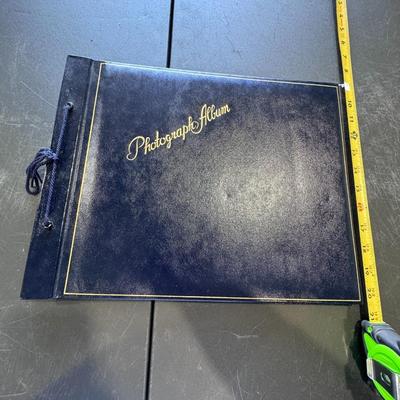
just album, no pics 605 / 1369 -
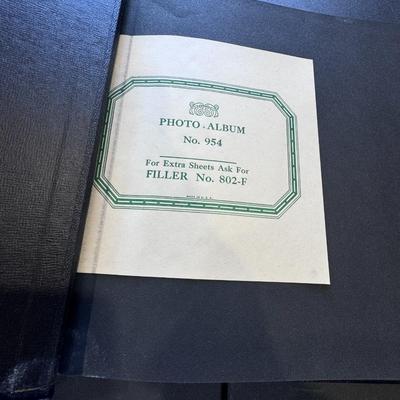
just album, no pics 606 / 1369 -
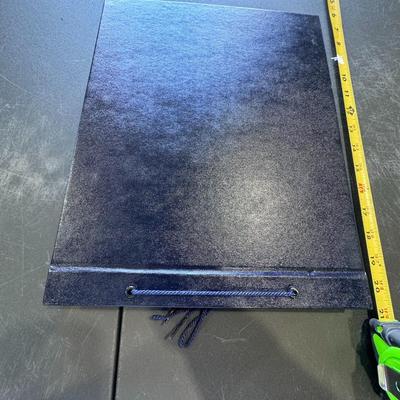
just album, no pics 607 / 1369 -
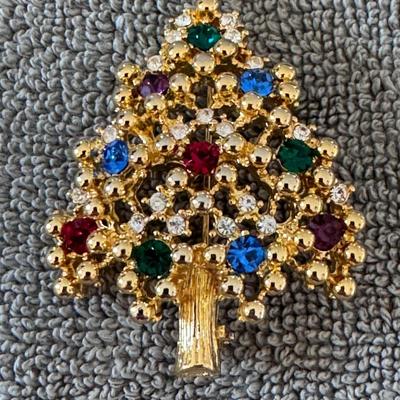
Vintage Eisenberg Ice Christmas Tree Brooch. Here's some information about this type of piece: Description: This particular brooch features a gold-tone setting adorned with numerous multicolored rhinestones, mimicking the festive appearance of a decorated Christmas tree. It often includes a mix of round, faceted rhinestones in various jewel tones like red, green, blue, and clear crystals. Designer: It's a product of Eisenberg Ice, a renowned line of costume jewelry known for its sparkling, high-quality rhinestone pieces that emulate fine jewelry. Collectibility: Eisenberg Christmas tree pins are highly collectible vintage costume jewelry pieces, especially those signed with the "Eisenberg Ice" mark. Era: These festive brooches were particularly popular, with many pieces from the mid-20th century onwards, including the 1970s and later, as indicated by the "Eisenberg Ice" marking. 608 / 1369 -
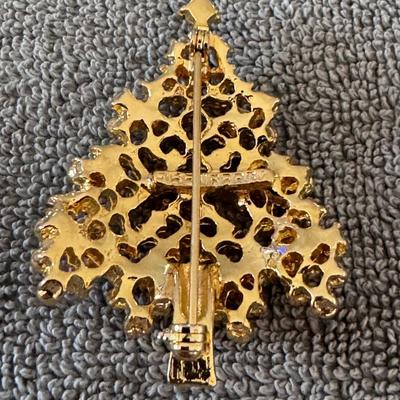
Vintage Eisenberg Ice Christmas Tree Brooch. Here's some information about this type of piece: Description: This particular brooch features a gold-tone setting adorned with numerous multicolored rhinestones, mimicking the festive appearance of a decorated Christmas tree. It often includes a mix of round, faceted rhinestones in various jewel tones like red, green, blue, and clear crystals. Designer: It's a product of Eisenberg Ice, a renowned line of costume jewelry known for its sparkling, high-quality rhinestone pieces that emulate fine jewelry. Collectibility: Eisenberg Christmas tree pins are highly collectible vintage costume jewelry pieces, especially those signed with the "Eisenberg Ice" mark. Era: These festive brooches were particularly popular, with many pieces from the mid-20th century onwards, including the 1970s and later, as indicated by the "Eisenberg Ice" marking. 609 / 1369 -
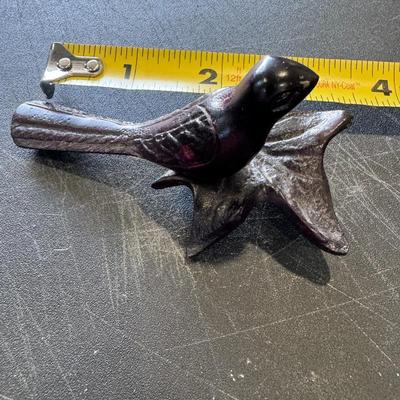
cast iron bird 4" sitting on leaf 610 / 1369 -
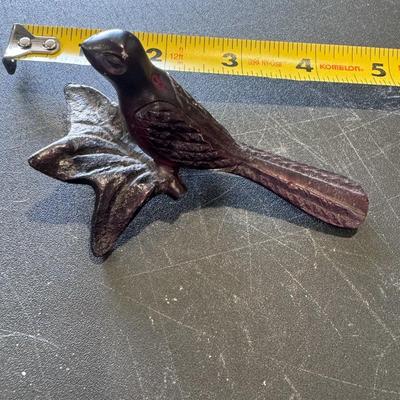
cast iron bird 4" sitting on leaf 611 / 1369 -
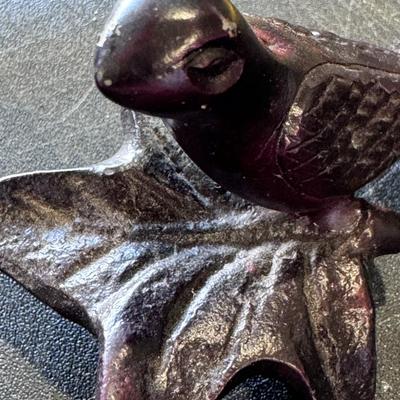
cast iron bird 4" sitting on leaf 612 / 1369 -
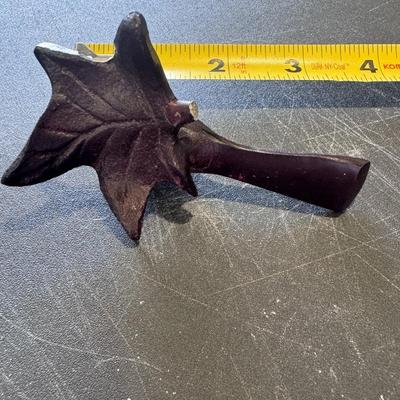
cast iron bird 4" sitting on leaf 613 / 1369 -
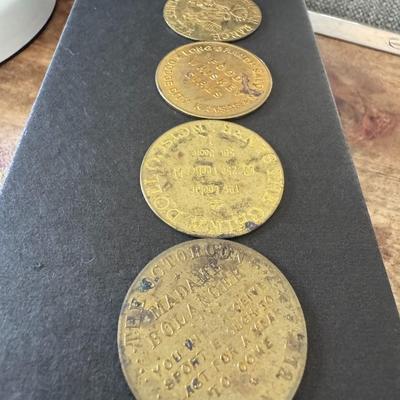
Purpose: Historically, such tokens were issued by brothels or saloons and could be exchanged for specific services, including an "all night" stay. They functioned as a form of pre-payment or credit, similar to a modern-day gift certificate or coupon, often advertising the establishment and its services. 618 / 1369 -
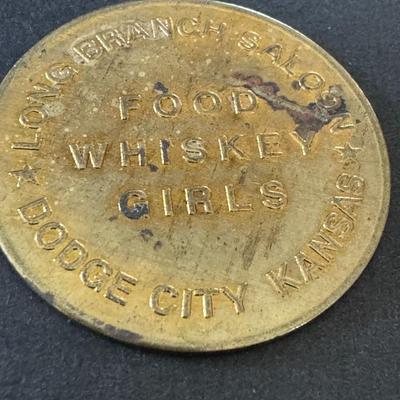
Purpose: Historically, such tokens were issued by brothels or saloons and could be exchanged for specific services, including an "all night" stay. They functioned as a form of pre-payment or credit, similar to a modern-day gift certificate or coupon, often advertising the establishment and its services. 619 / 1369 -
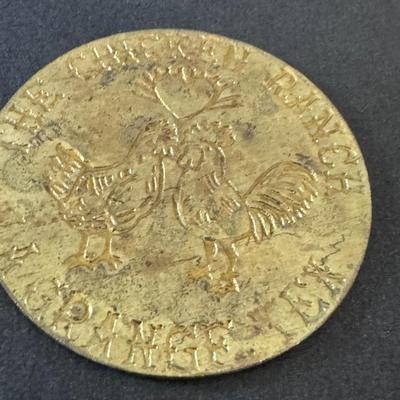
Purpose: Historically, such tokens were issued by brothels or saloons and could be exchanged for specific services, including an "all night" stay. They functioned as a form of pre-payment or credit, similar to a modern-day gift certificate or coupon, often advertising the establishment and its services. 620 / 1369 -
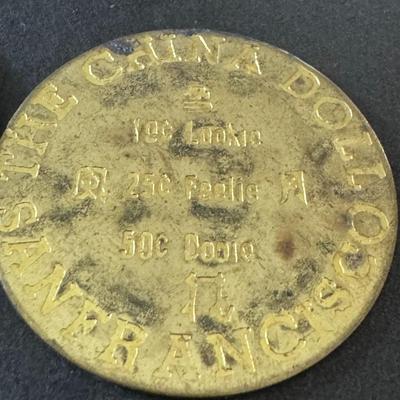
Purpose: Historically, such tokens were issued by brothels or saloons and could be exchanged for specific services, including an "all night" stay. They functioned as a form of pre-payment or credit, similar to a modern-day gift certificate or coupon, often advertising the establishment and its services. 621 / 1369 -
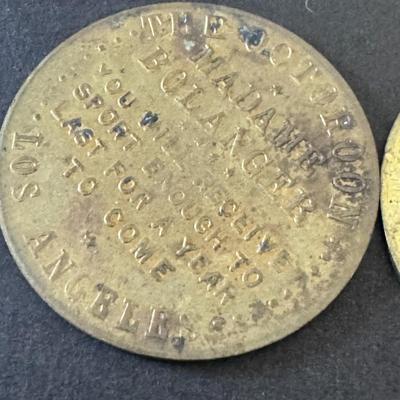
Purpose: Historically, such tokens were issued by brothels or saloons and could be exchanged for specific services, including an "all night" stay. They functioned as a form of pre-payment or credit, similar to a modern-day gift certificate or coupon, often advertising the establishment and its services. 622 / 1369 -
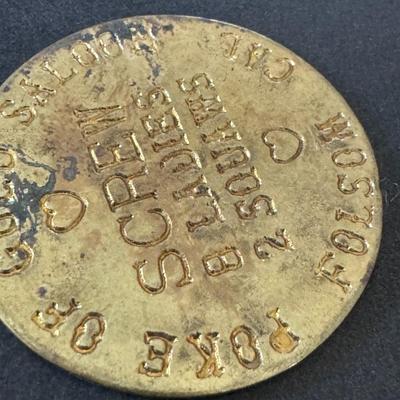
Purpose: Historically, such tokens were issued by brothels or saloons and could be exchanged for specific services, including an "all night" stay. They functioned as a form of pre-payment or credit, similar to a modern-day gift certificate or coupon, often advertising the establishment and its services. 623 / 1369 -
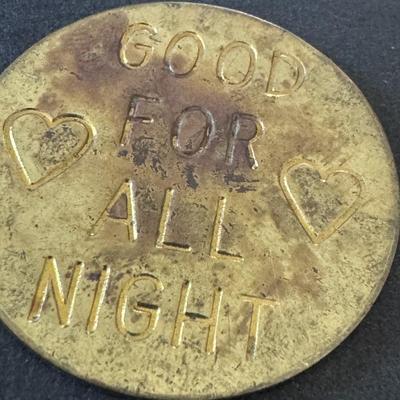
Purpose: Historically, such tokens were issued by brothels or saloons and could be exchanged for specific services, including an "all night" stay. They functioned as a form of pre-payment or credit, similar to a modern-day gift certificate or coupon, often advertising the establishment and its services. 624 / 1369 -
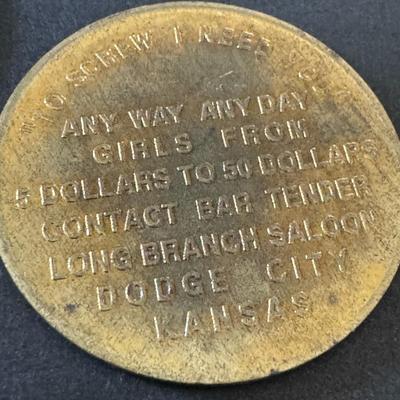
Purpose: Historically, such tokens were issued by brothels or saloons and could be exchanged for specific services, including an "all night" stay. They functioned as a form of pre-payment or credit, similar to a modern-day gift certificate or coupon, often advertising the establishment and its services. 625 / 1369 -
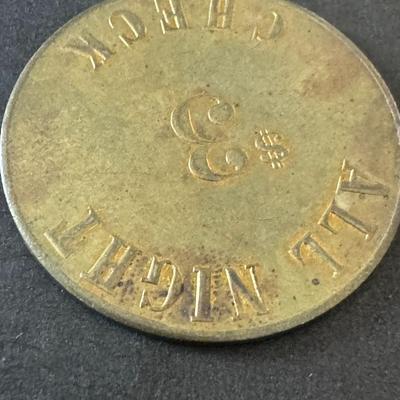
Purpose: Historically, such tokens were issued by brothels or saloons and could be exchanged for specific services, including an "all night" stay. They functioned as a form of pre-payment or credit, similar to a modern-day gift certificate or coupon, often advertising the establishment and its services. 626 / 1369 -
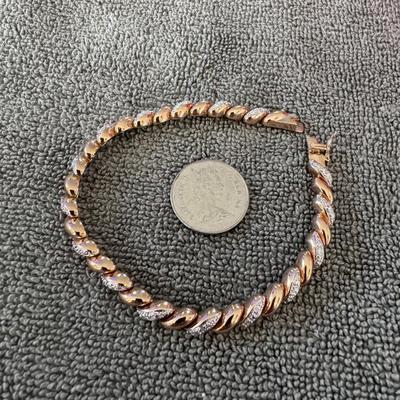
Gold Toned Sterling Silver and Tiny Diamond Tennis Bracelet, presented on a textured grey surface, with a coin placed in the center for scale. Here's more information about the bracelet: Material and Design: The bracelet is crafted from .925 sterling silver with a gold-toned overlay, likely a rose gold tone, and features sparkling diamond accents or cubic zirconia, giving it a luxurious and elegant appearance. The design appears to be a variation of a tennis bracelet, characterized by a continuous line of stones. Dimensions: Similar bracelets are described as being approximately 7 inches long and 5mm wide, weighing around 16.32 grams. Closure: These types of bracelets often feature a secure box clasp with a safety latch. 627 / 1369 -
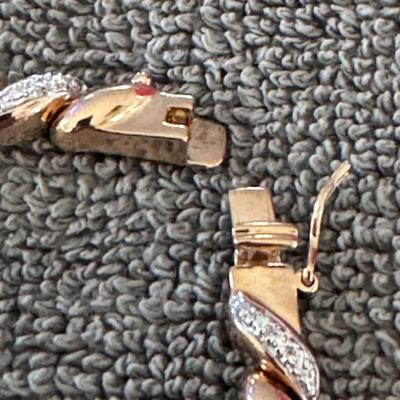
Gold Toned Sterling Silver and Tiny Diamond Tennis Bracelet, presented on a textured grey surface, with a coin placed in the center for scale. Here's more information about the bracelet: Material and Design: The bracelet is crafted from .925 sterling silver with a gold-toned overlay, likely a rose gold tone, and features sparkling diamond accents or cubic zirconia, giving it a luxurious and elegant appearance. The design appears to be a variation of a tennis bracelet, characterized by a continuous line of stones. Dimensions: Similar bracelets are described as being approximately 7 inches long and 5mm wide, weighing around 16.32 grams. Closure: These types of bracelets often feature a secure box clasp with a safety latch. 628 / 1369 -
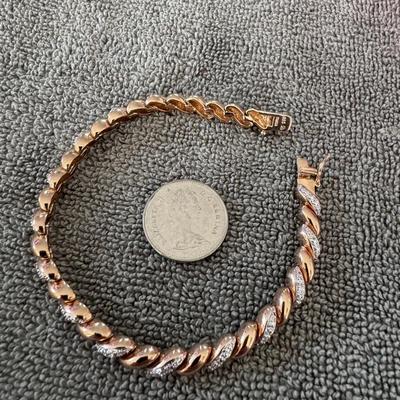
Gold Toned Sterling Silver and Tiny Diamond Tennis Bracelet, presented on a textured grey surface, with a coin placed in the center for scale. Here's more information about the bracelet: Material and Design: The bracelet is crafted from .925 sterling silver with a gold-toned overlay, likely a rose gold tone, and features sparkling diamond accents or cubic zirconia, giving it a luxurious and elegant appearance. The design appears to be a variation of a tennis bracelet, characterized by a continuous line of stones. Dimensions: Similar bracelets are described as being approximately 7 inches long and 5mm wide, weighing around 16.32 grams. Closure: These types of bracelets often feature a secure box clasp with a safety latch. 629 / 1369 -
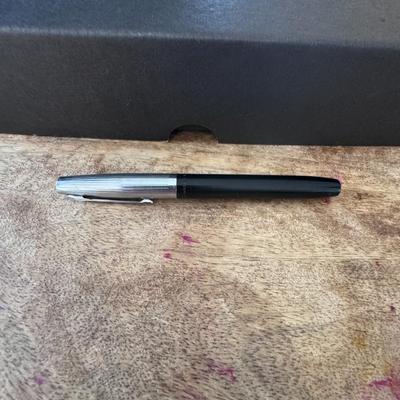
Sheaffer pen, specifically identified by the "SHEAFFER'S" engraving visible on the pen's body. About Sheaffer Pens: Founded: Sheaffer Pen Corporation was founded in Fort Madison, Iowa, in 1913 by Walter A. Sheaffer, who patented a lever-filling fountain pen, revolutionizing the writing instrument industry. Iconic Features: Sheaffer is known for its distinctive designs and innovations, including the iconic "White Dot" introduced in the 1920s, which symbolized quality and a lifetime warranty on premium pens. 630 / 1369 -
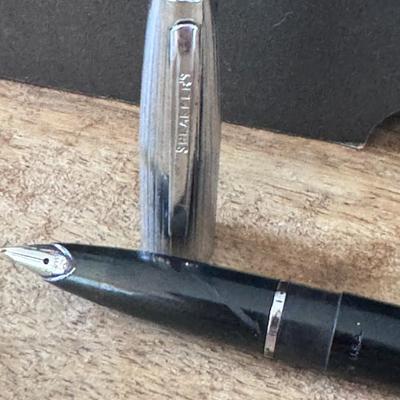
Sheaffer pen, specifically identified by the "SHEAFFER'S" engraving visible on the pen's body. About Sheaffer Pens: Founded: Sheaffer Pen Corporation was founded in Fort Madison, Iowa, in 1913 by Walter A. Sheaffer, who patented a lever-filling fountain pen, revolutionizing the writing instrument industry. Iconic Features: Sheaffer is known for its distinctive designs and innovations, including the iconic "White Dot" introduced in the 1920s, which symbolized quality and a lifetime warranty on premium pens. 631 / 1369 -
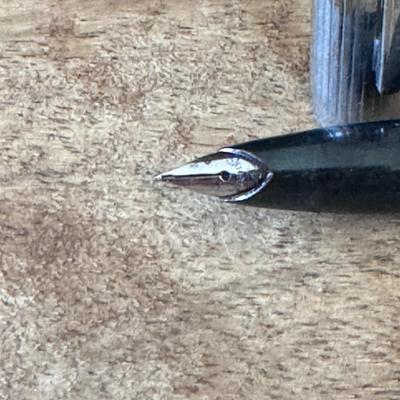
Sheaffer pen, specifically identified by the "SHEAFFER'S" engraving visible on the pen's body. About Sheaffer Pens: Founded: Sheaffer Pen Corporation was founded in Fort Madison, Iowa, in 1913 by Walter A. Sheaffer, who patented a lever-filling fountain pen, revolutionizing the writing instrument industry. Iconic Features: Sheaffer is known for its distinctive designs and innovations, including the iconic "White Dot" introduced in the 1920s, which symbolized quality and a lifetime warranty on premium pens. 632 / 1369 -
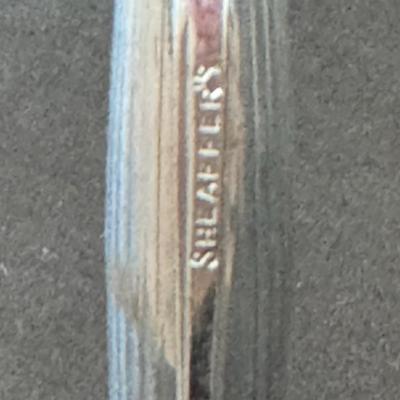
Sheaffer pen, specifically identified by the "SHEAFFER'S" engraving visible on the pen's body. About Sheaffer Pens: Founded: Sheaffer Pen Corporation was founded in Fort Madison, Iowa, in 1913 by Walter A. Sheaffer, who patented a lever-filling fountain pen, revolutionizing the writing instrument industry. Iconic Features: Sheaffer is known for its distinctive designs and innovations, including the iconic "White Dot" introduced in the 1920s, which symbolized quality and a lifetime warranty on premium pens. 633 / 1369 -
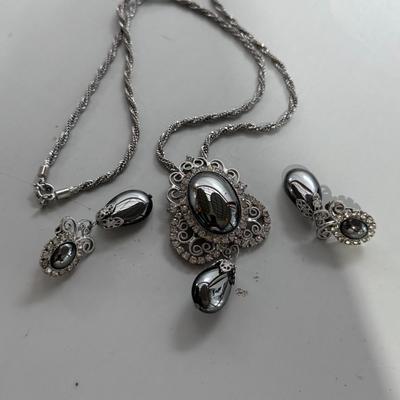
The image displays a vintage jewelry set featuring a necklace with a pendant and matching clip-on earrings, notably incorporating hematite stones and clear rhinestones. Here's more information about this style of jewelry: Materials and Design: The set is crafted from silver-tone metal and features large, polished hematite cabochons (likely faux hematite glass) as the central stones, surrounded by brilliant clear rhinestones. The pendant often has an intricate setting, sometimes featuring heart or scroll designs. Potential Designers: This style is characteristic of vintage costume jewelry, particularly from the mid-20th century. Similar pieces are often attributed to Whiting & Davis or DeLizza & Elster (known as Juliana). 634 / 1369 -
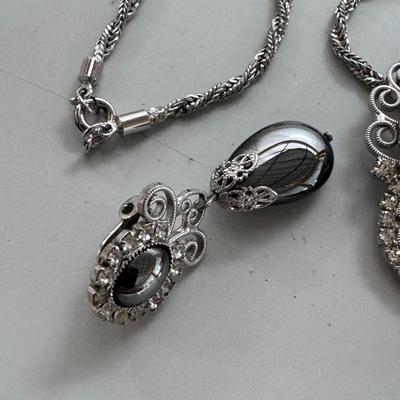
The image displays a vintage jewelry set featuring a necklace with a pendant and matching clip-on earrings, notably incorporating hematite stones and clear rhinestones. Here's more information about this style of jewelry: Materials and Design: The set is crafted from silver-tone metal and features large, polished hematite cabochons (likely faux hematite glass) as the central stones, surrounded by brilliant clear rhinestones. The pendant often has an intricate setting, sometimes featuring heart or scroll designs. Potential Designers: This style is characteristic of vintage costume jewelry, particularly from the mid-20th century. Similar pieces are often attributed to Whiting & Davis or DeLizza & Elster (known as Juliana). 635 / 1369 -
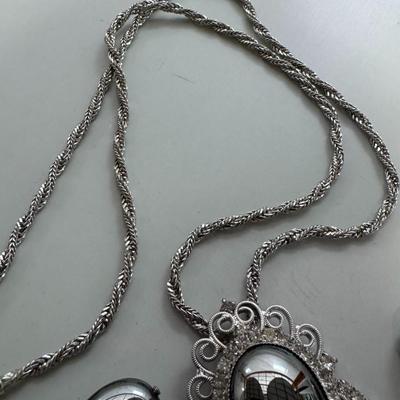
The image displays a vintage jewelry set featuring a necklace with a pendant and matching clip-on earrings, notably incorporating hematite stones and clear rhinestones. Here's more information about this style of jewelry: Materials and Design: The set is crafted from silver-tone metal and features large, polished hematite cabochons (likely faux hematite glass) as the central stones, surrounded by brilliant clear rhinestones. The pendant often has an intricate setting, sometimes featuring heart or scroll designs. Potential Designers: This style is characteristic of vintage costume jewelry, particularly from the mid-20th century. Similar pieces are often attributed to Whiting & Davis or DeLizza & Elster (known as Juliana). 636 / 1369 -
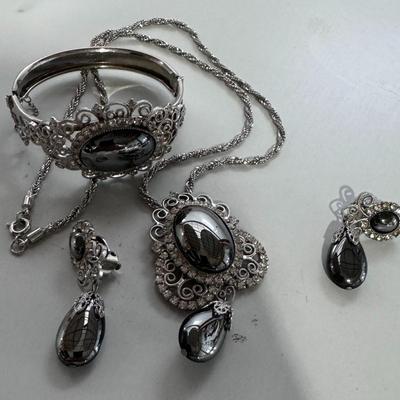
The image displays a vintage jewelry set featuring a necklace with a pendant and matching clip-on earrings, notably incorporating hematite stones and clear rhinestones. Here's more information about this style of jewelry: Materials and Design: The set is crafted from silver-tone metal and features large, polished hematite cabochons (likely faux hematite glass) as the central stones, surrounded by brilliant clear rhinestones. The pendant often has an intricate setting, sometimes featuring heart or scroll designs. Potential Designers: This style is characteristic of vintage costume jewelry, particularly from the mid-20th century. Similar pieces are often attributed to Whiting & Davis or DeLizza & Elster (known as Juliana). 637 / 1369 -
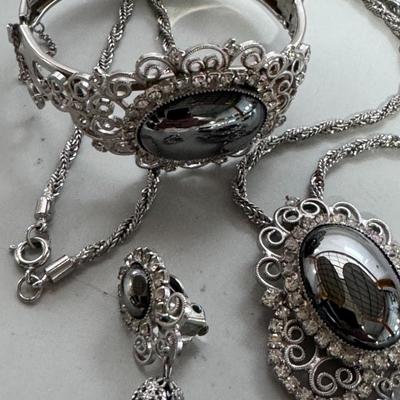
The image displays a vintage jewelry set featuring a necklace with a pendant and matching clip-on earrings, notably incorporating hematite stones and clear rhinestones. Here's more information about this style of jewelry: Materials and Design: The set is crafted from silver-tone metal and features large, polished hematite cabochons (likely faux hematite glass) as the central stones, surrounded by brilliant clear rhinestones. The pendant often has an intricate setting, sometimes featuring heart or scroll designs. Potential Designers: This style is characteristic of vintage costume jewelry, particularly from the mid-20th century. Similar pieces are often attributed to Whiting & Davis or DeLizza & Elster (known as Juliana). 638 / 1369 -

Vintage 1974 Mego Captain Kirk Original Star Trek Action Figure. This Mego figure of Captain James T. Kirk, famously portrayed by William Shatner in the television show and movies, features his iconic gold uniform and accessories like a phaser. These figures, released in 1974, were known for their detailed 8-inch size, cloth uniforms, and articulation. The head sculpt on this figure is considered quite accurate to William Shatner's likeness. The boots are painted on and not removable. Mego's Star Trek action figures were first released in 1974 and included Captain Kirk, Mr. Spock, Dr. McCoy (Bones), Mr. Scott (Scottie), and the Klingon. Lieutenant Uhura was added to the series later. 639 / 1369 -
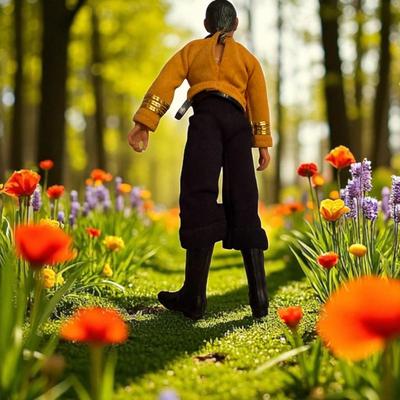
Vintage 1974 Mego Captain Kirk Original Star Trek Action Figure. This Mego figure of Captain James T. Kirk, famously portrayed by William Shatner in the television show and movies, features his iconic gold uniform and accessories like a phaser. These figures, released in 1974, were known for their detailed 8-inch size, cloth uniforms, and articulation. The head sculpt on this figure is considered quite accurate to William Shatner's likeness. The boots are painted on and not removable. Mego's Star Trek action figures were first released in 1974 and included Captain Kirk, Mr. Spock, Dr. McCoy (Bones), Mr. Scott (Scottie), and the Klingon. Lieutenant Uhura was added to the series later. 640 / 1369 -

Vintage 1974 Mego Captain Kirk Original Star Trek Action Figure. This Mego figure of Captain James T. Kirk, famously portrayed by William Shatner in the television show and movies, features his iconic gold uniform and accessories like a phaser. These figures, released in 1974, were known for their detailed 8-inch size, cloth uniforms, and articulation. The head sculpt on this figure is considered quite accurate to William Shatner's likeness. The boots are painted on and not removable. Mego's Star Trek action figures were first released in 1974 and included Captain Kirk, Mr. Spock, Dr. McCoy (Bones), Mr. Scott (Scottie), and the Klingon. Lieutenant Uhura was added to the series later. 641 / 1369 -
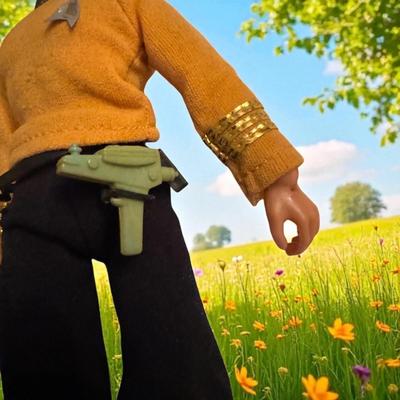
Vintage 1974 Mego Captain Kirk Original Star Trek Action Figure. This Mego figure of Captain James T. Kirk, famously portrayed by William Shatner in the television show and movies, features his iconic gold uniform and accessories like a phaser. These figures, released in 1974, were known for their detailed 8-inch size, cloth uniforms, and articulation. The head sculpt on this figure is considered quite accurate to William Shatner's likeness. The boots are painted on and not removable. Mego's Star Trek action figures were first released in 1974 and included Captain Kirk, Mr. Spock, Dr. McCoy (Bones), Mr. Scott (Scottie), and the Klingon. Lieutenant Uhura was added to the series later. 642 / 1369 -
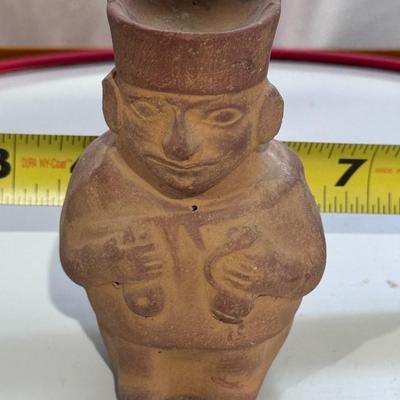
Mochica Medicine Man figure, Here's more information about this type of figure: Origin & Style: It is based on ancient Moche (also known as Mochica) pottery from the northern coast of Peru, known for its distinctive figures and vessels depicting everyday life, rituals, and deities. "Medicine Man" Representation: The figure portrays a "medicine man" or "curandero," a significant figure in Moche society, believed to possess healing and spiritual powers. Potential as Advertising Memorabilia: Some versions of this figure, like the one seen in several search results, were used as promotional items for Tinactin, an antifungal medication, particularly during the 1960s-70s. 643 / 1369 -
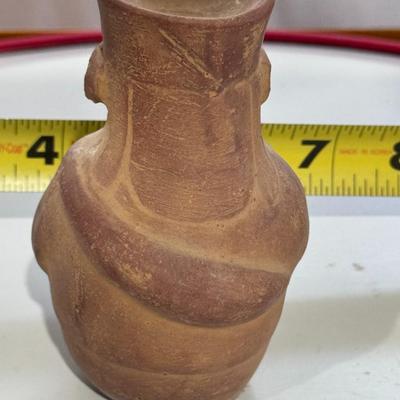
Mochica Medicine Man figure, Here's more information about this type of figure: Origin & Style: It is based on ancient Moche (also known as Mochica) pottery from the northern coast of Peru, known for its distinctive figures and vessels depicting everyday life, rituals, and deities. "Medicine Man" Representation: The figure portrays a "medicine man" or "curandero," a significant figure in Moche society, believed to possess healing and spiritual powers. Potential as Advertising Memorabilia: Some versions of this figure, like the one seen in several search results, were used as promotional items for Tinactin, an antifungal medication, particularly during the 1960s-70s. 644 / 1369 -
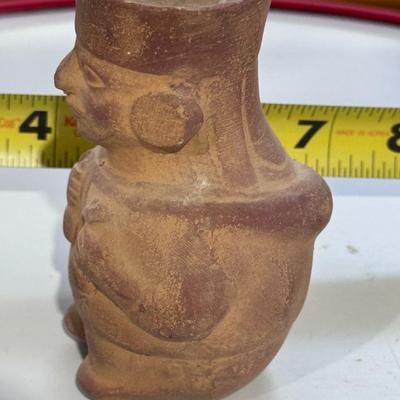
Mochica Medicine Man figure, Here's more information about this type of figure: Origin & Style: It is based on ancient Moche (also known as Mochica) pottery from the northern coast of Peru, known for its distinctive figures and vessels depicting everyday life, rituals, and deities. "Medicine Man" Representation: The figure portrays a "medicine man" or "curandero," a significant figure in Moche society, believed to possess healing and spiritual powers. Potential as Advertising Memorabilia: Some versions of this figure, like the one seen in several search results, were used as promotional items for Tinactin, an antifungal medication, particularly during the 1960s-70s. 645 / 1369 -
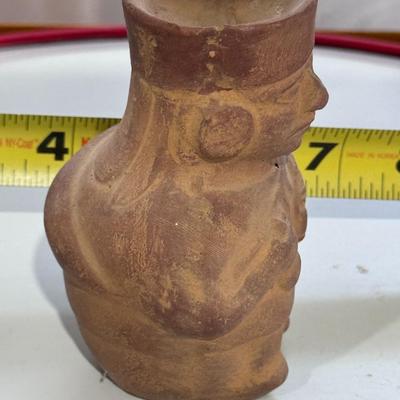
Mochica Medicine Man figure, Here's more information about this type of figure: Origin & Style: It is based on ancient Moche (also known as Mochica) pottery from the northern coast of Peru, known for its distinctive figures and vessels depicting everyday life, rituals, and deities. "Medicine Man" Representation: The figure portrays a "medicine man" or "curandero," a significant figure in Moche society, believed to possess healing and spiritual powers. Potential as Advertising Memorabilia: Some versions of this figure, like the one seen in several search results, were used as promotional items for Tinactin, an antifungal medication, particularly during the 1960s-70s. 646 / 1369 -

The image shows a K88 Multi-function Anti-Spy Detector, a device designed to detect hidden surveillance equipment. The K88 Multi-function Anti-Spy Detector is a device designed to detect hidden surveillance equipment. There are a number of devices on the market that are designed to detect various types of surveillance equipment, including hidden cameras and audio recording devices. 647 / 1369 -
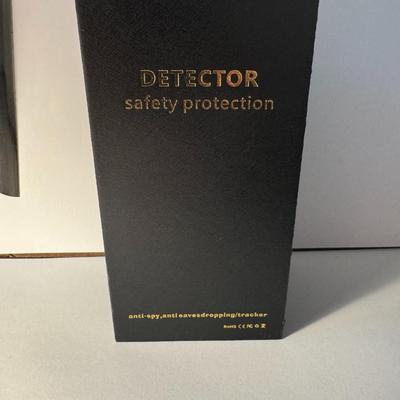
The image shows a K88 Multi-function Anti-Spy Detector, a device designed to detect hidden surveillance equipment. The K88 Multi-function Anti-Spy Detector is a device designed to detect hidden surveillance equipment. There are a number of devices on the market that are designed to detect various types of surveillance equipment, including hidden cameras and audio recording devices. 648 / 1369 -

The image shows a K88 Multi-function Anti-Spy Detector, a device designed to detect hidden surveillance equipment. The K88 Multi-function Anti-Spy Detector is a device designed to detect hidden surveillance equipment. There are a number of devices on the market that are designed to detect various types of surveillance equipment, including hidden cameras and audio recording devices. 649 / 1369 -
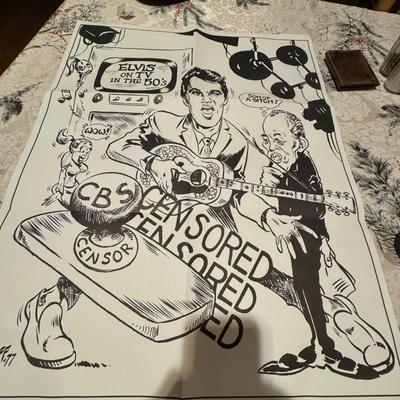
A satire poster by an artist named Ryff, depicting Elvis Presley's appearance on television in the 1950s. The poster specifically highlights the censorship that occurred during this time, where Elvis' performances were sometimes only shown from the waist up due to concerns about his "provocative" hip movements. The poster, created in 1977, is titled "ELVIS ON TV IN THE 50's". It is described as a rare, original caricature that measures approximately 23"x28". The censorship of Elvis' performances on shows like The Ed Sullivan Show was a notable cultural moment in the 1950s, reflecting the tensions between rock and roll's emerging popularity and more conservative views on television content. 653 / 1369 -
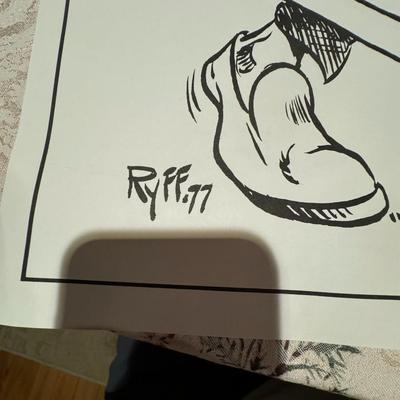
A satire poster by an artist named Ryff, depicting Elvis Presley's appearance on television in the 1950s. The poster specifically highlights the censorship that occurred during this time, where Elvis' performances were sometimes only shown from the waist up due to concerns about his "provocative" hip movements. The poster, created in 1977, is titled "ELVIS ON TV IN THE 50's". It is described as a rare, original caricature that measures approximately 23"x28". The censorship of Elvis' performances on shows like The Ed Sullivan Show was a notable cultural moment in the 1950s, reflecting the tensions between rock and roll's emerging popularity and more conservative views on television content. 654 / 1369 -
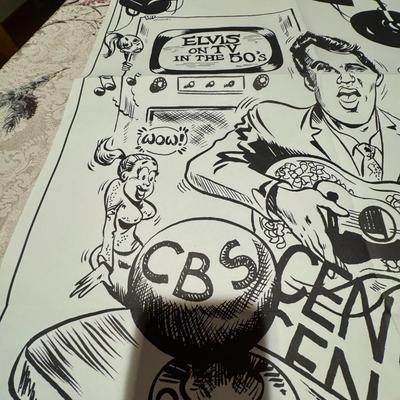
A satire poster by an artist named Ryff, depicting Elvis Presley's appearance on television in the 1950s. The poster specifically highlights the censorship that occurred during this time, where Elvis' performances were sometimes only shown from the waist up due to concerns about his "provocative" hip movements. The poster, created in 1977, is titled "ELVIS ON TV IN THE 50's". It is described as a rare, original caricature that measures approximately 23"x28". The censorship of Elvis' performances on shows like The Ed Sullivan Show was a notable cultural moment in the 1950s, reflecting the tensions between rock and roll's emerging popularity and more conservative views on television content. 655 / 1369 -
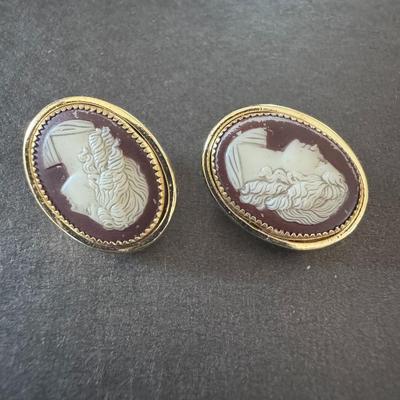
Details about the earrings: They feature a classic cameo design, likely carved from shell or hardstone, depicting a profile against a contrasting background. The cameos are set in oval-shaped, gold-toned frames, possibly dating back to the Victorian era or later, given the style's popularity during that time. The fact that there are two matching pieces strongly suggests they are earrings, as opposed to a single brooch or pendant. 656 / 1369 -
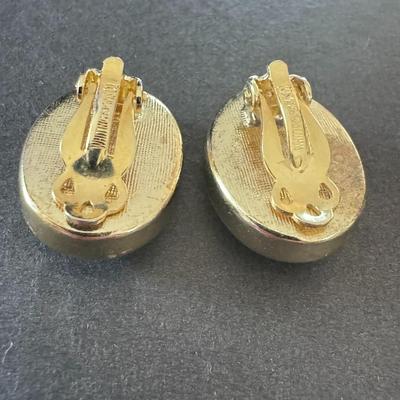
Details about the earrings: They feature a classic cameo design, likely carved from shell or hardstone, depicting a profile against a contrasting background. The cameos are set in oval-shaped, gold-toned frames, possibly dating back to the Victorian era or later, given the style's popularity during that time. The fact that there are two matching pieces strongly suggests they are earrings, as opposed to a single brooch or pendant. 657 / 1369 -
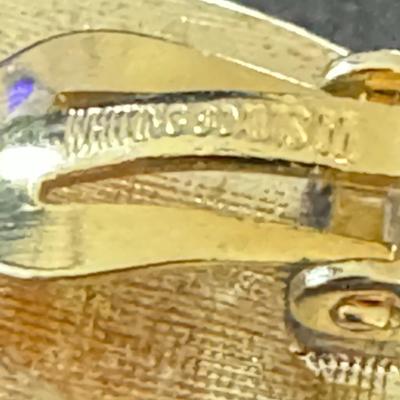
Details about the earrings: They feature a classic cameo design, likely carved from shell or hardstone, depicting a profile against a contrasting background. The cameos are set in oval-shaped, gold-toned frames, possibly dating back to the Victorian era or later, given the style's popularity during that time. The fact that there are two matching pieces strongly suggests they are earrings, as opposed to a single brooch or pendant. 658 / 1369 -
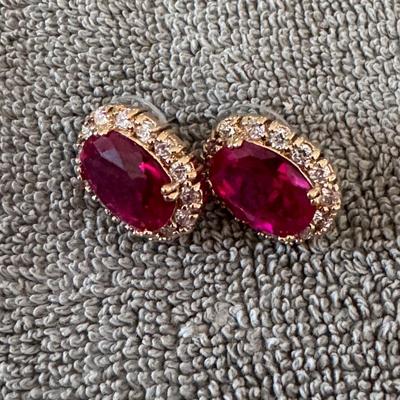
Elegant possibly ruby and diamond halo stud earrings. : Gemstones: They feature a vibrant red, likely oval-cut stone as the center stone, encircled by a halo of smaller, sparkling stones. Rubies are the July birthstone and are known for their deep red hue, symbolizing passion and protection. Setting: The gemstones are set in a classic halo design, which enhances the central ruby's size and brilliance by surrounding it with dazzling glimmer Metal: While the specific metal isn't definitively stated in the image, similar styles are often crafted in yellow gold, rose gold, or white gold. The warmth of the metal in the image suggests it could be yellow or rose gold.- possibly? Not certain Style: These are stud earrings, designed to sit directly on the earlobe, making them versatile for both everyday wear and special occasions. 663 / 1369 -
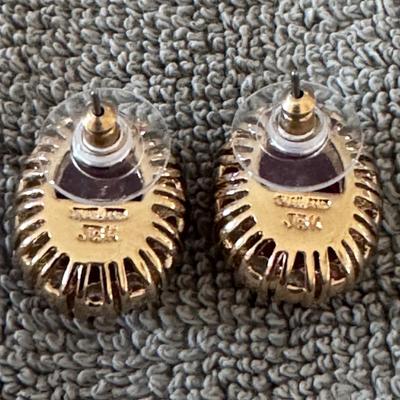
Elegant possibly ruby and diamond halo stud earrings. : Gemstones: They feature a vibrant red, likely oval-cut stone as the center stone, encircled by a halo of smaller, sparkling stones. Rubies are the July birthstone and are known for their deep red hue, symbolizing passion and protection. Setting: The gemstones are set in a classic halo design, which enhances the central ruby's size and brilliance by surrounding it with dazzling glimmer Metal: While the specific metal isn't definitively stated in the image, similar styles are often crafted in yellow gold, rose gold, or white gold. The warmth of the metal in the image suggests it could be yellow or rose gold.- possibly? Not certain Style: These are stud earrings, designed to sit directly on the earlobe, making them versatile for both everyday wear and special occasions. 664 / 1369 -
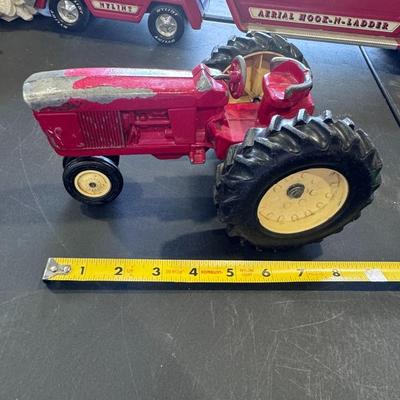
solid but needs a re-paint and new decals 665 / 1369 -
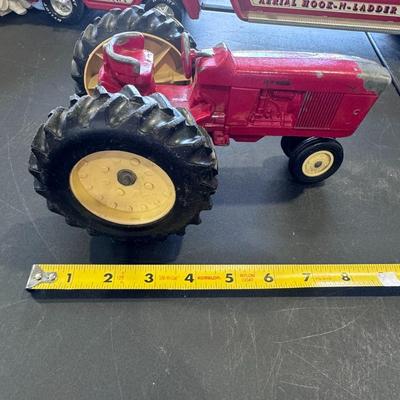
solid but needs a re-paint and new decals 666 / 1369 -
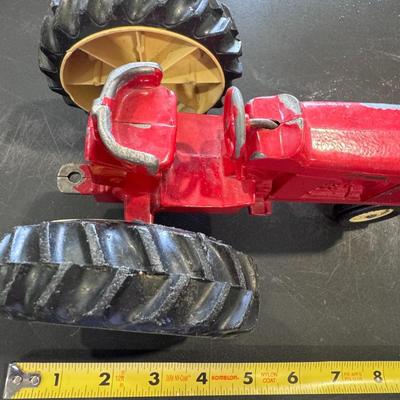
solid but needs a re-paint and new decals 667 / 1369 -
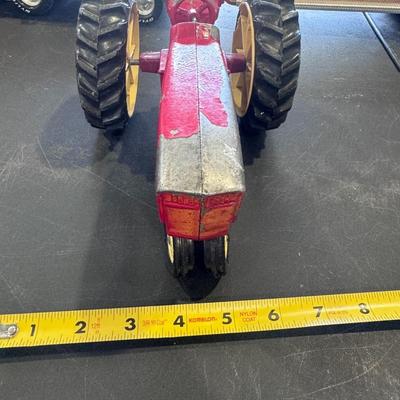
solid but needs a re-paint and new decals 668 / 1369 -
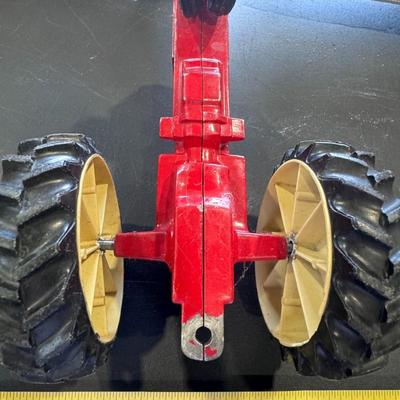
solid but needs a re-paint and new decals 669 / 1369 -
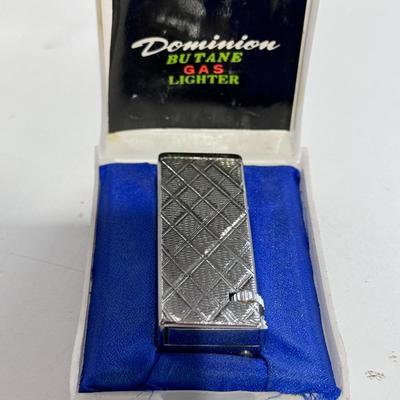
Nice Older lighter / appears unused 670 / 1369 -
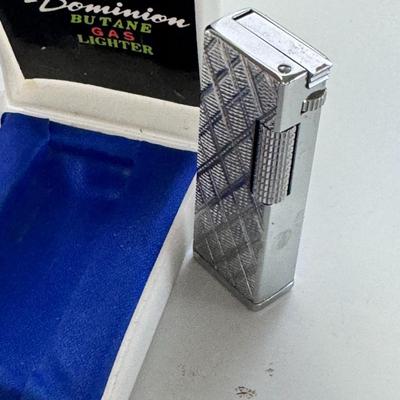
Nice Older lighter / appears unused 671 / 1369 -
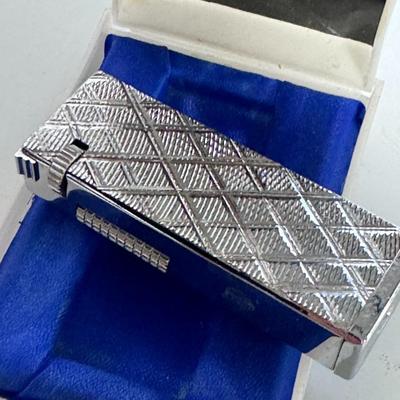
Nice Older lighter / appears unused 672 / 1369 -
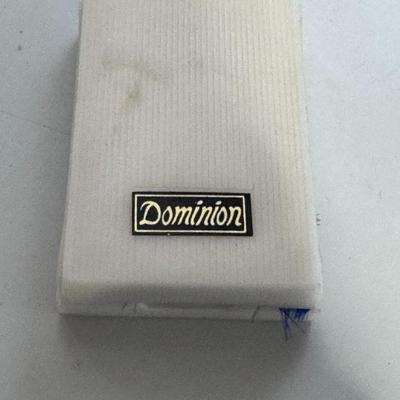
Nice Older lighter / appears unused 673 / 1369 -
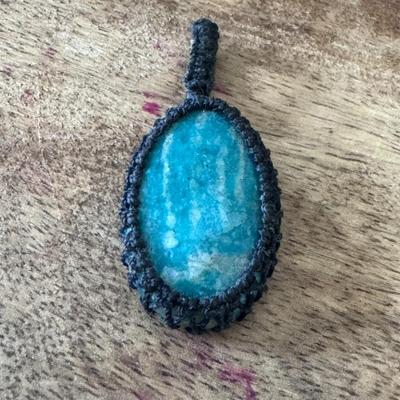
set within a woven macrame design, creating a distinctive and often bohemian-style accessory. About Chrysocolla: Appearance: Chrysocolla is known for its striking blue, blue-green, and sometimes green hues, often displaying a mix of colors and patterns within the stone. Properties & Meaning: It's considered a soothing and communicative stone in crystal healing, associated with the throat chakra and promoting self-expression, inner peace, and healthy relationships. Geology: Chrysocolla is a copper-bearing mineral typically found in the oxidation zones of copper ore deposits. 674 / 1369 -
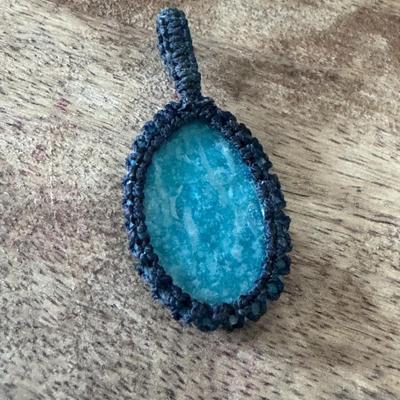
set within a woven macrame design, creating a distinctive and often bohemian-style accessory. About Chrysocolla: Appearance: Chrysocolla is known for its striking blue, blue-green, and sometimes green hues, often displaying a mix of colors and patterns within the stone. Properties & Meaning: It's considered a soothing and communicative stone in crystal healing, associated with the throat chakra and promoting self-expression, inner peace, and healthy relationships. Geology: Chrysocolla is a copper-bearing mineral typically found in the oxidation zones of copper ore deposits. 675 / 1369 -
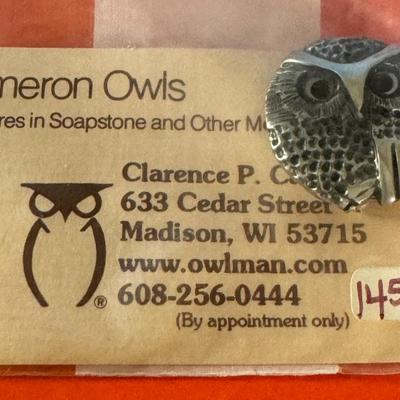
Cameron Owls is the creation of Clarence P. Cameron, known as "The Owlman." He is a Wisconsin artist who has sculpted owls from various materials, including soapstone, bronze, pewter, and copper, for over 45 years. He was also the founder of the Wisconsin Alliance of Artists and Craftspeople. Clarence Cameron passed away in June 2024 at the age of 83. RIP 683 / 1369 -
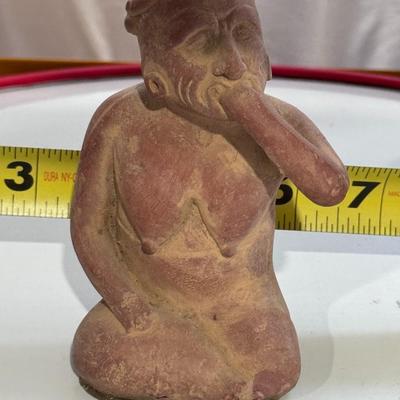
The figure in your image is a Vintage "Portrait of Anxiety/Depression" Clay Pottery Figure, which is a 1960s promotional piece for a prescription drug company in Mexico, believed to be Etrafon. Here's more information about this intriguing figure: Origin and Purpose: It's a vintage advertising piece created in the 1960s for a pharmaceutical company in Mexico, likely promoting the tranquilizer Etrafon. It's often referred to as "Portrait of Anxiety/Depression" due to its expressive posture. Style and Inspiration: While it's a modern promotional item, its design is inspired by Pre-Columbian art, particularly the style of figures found in Jaina, Mexico, dating back to around 800 AD. Materials: The figure is made of clay pottery or ceramic, often in terracotta or brick-red tones. 684 / 1369 -
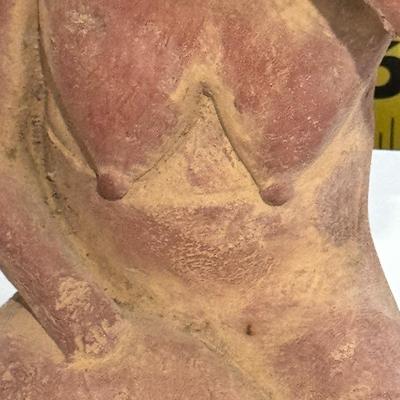
The figure in your image is a Vintage "Portrait of Anxiety/Depression" Clay Pottery Figure, which is a 1960s promotional piece for a prescription drug company in Mexico, believed to be Etrafon. Here's more information about this intriguing figure: Origin and Purpose: It's a vintage advertising piece created in the 1960s for a pharmaceutical company in Mexico, likely promoting the tranquilizer Etrafon. It's often referred to as "Portrait of Anxiety/Depression" due to its expressive posture. Style and Inspiration: While it's a modern promotional item, its design is inspired by Pre-Columbian art, particularly the style of figures found in Jaina, Mexico, dating back to around 800 AD. Materials: The figure is made of clay pottery or ceramic, often in terracotta or brick-red tones. 685 / 1369 -
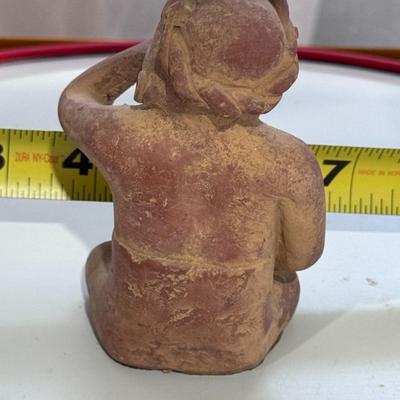
The figure in your image is a Vintage "Portrait of Anxiety/Depression" Clay Pottery Figure, which is a 1960s promotional piece for a prescription drug company in Mexico, believed to be Etrafon. Here's more information about this intriguing figure: Origin and Purpose: It's a vintage advertising piece created in the 1960s for a pharmaceutical company in Mexico, likely promoting the tranquilizer Etrafon. It's often referred to as "Portrait of Anxiety/Depression" due to its expressive posture. Style and Inspiration: While it's a modern promotional item, its design is inspired by Pre-Columbian art, particularly the style of figures found in Jaina, Mexico, dating back to around 800 AD. Materials: The figure is made of clay pottery or ceramic, often in terracotta or brick-red tones. 686 / 1369 -
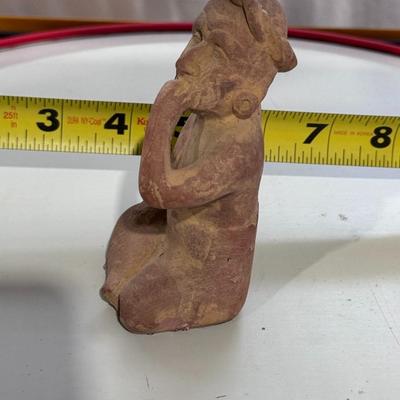
The figure in your image is a Vintage "Portrait of Anxiety/Depression" Clay Pottery Figure, which is a 1960s promotional piece for a prescription drug company in Mexico, believed to be Etrafon. Here's more information about this intriguing figure: Origin and Purpose: It's a vintage advertising piece created in the 1960s for a pharmaceutical company in Mexico, likely promoting the tranquilizer Etrafon. It's often referred to as "Portrait of Anxiety/Depression" due to its expressive posture. Style and Inspiration: While it's a modern promotional item, its design is inspired by Pre-Columbian art, particularly the style of figures found in Jaina, Mexico, dating back to around 800 AD. Materials: The figure is made of clay pottery or ceramic, often in terracotta or brick-red tones. 687 / 1369 -
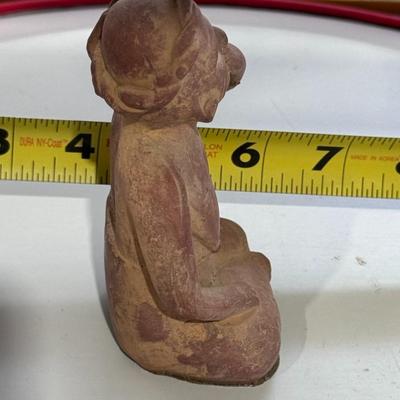
The figure in your image is a Vintage "Portrait of Anxiety/Depression" Clay Pottery Figure, which is a 1960s promotional piece for a prescription drug company in Mexico, believed to be Etrafon. Here's more information about this intriguing figure: Origin and Purpose: It's a vintage advertising piece created in the 1960s for a pharmaceutical company in Mexico, likely promoting the tranquilizer Etrafon. It's often referred to as "Portrait of Anxiety/Depression" due to its expressive posture. Style and Inspiration: While it's a modern promotional item, its design is inspired by Pre-Columbian art, particularly the style of figures found in Jaina, Mexico, dating back to around 800 AD. Materials: The figure is made of clay pottery or ceramic, often in terracotta or brick-red tones. 688 / 1369 -
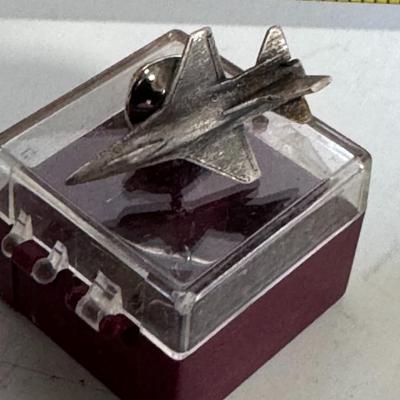
F-16 fighter jet lapel pin, also known as a stick pin or tie tack. Here's some information about this type of item: Design: It features a detailed representation of the F-16 Fighting Falcon, a prominent military aircraft, often made of silver-toned metal or pewter. Purpose: These pins are primarily used as accessories on lapels, hats, vests, or other attire to show support for the US Air Force, aviation, or as a collectible item. 689 / 1369 -
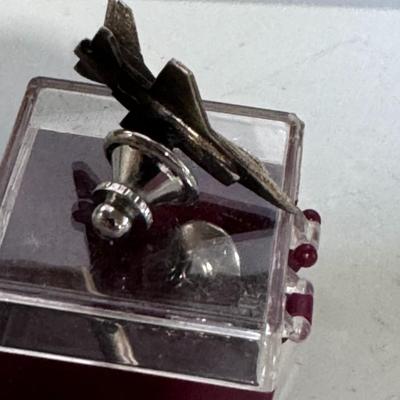
F-16 fighter jet lapel pin, also known as a stick pin or tie tack. Here's some information about this type of item: Design: It features a detailed representation of the F-16 Fighting Falcon, a prominent military aircraft, often made of silver-toned metal or pewter. Purpose: These pins are primarily used as accessories on lapels, hats, vests, or other attire to show support for the US Air Force, aviation, or as a collectible item. 690 / 1369 -
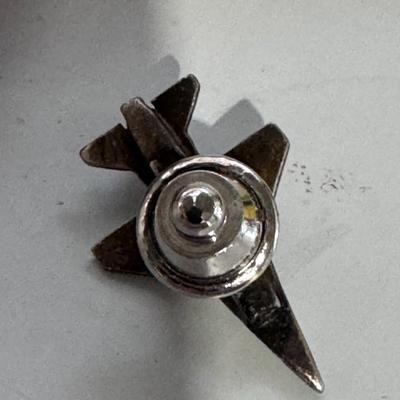
F-16 fighter jet lapel pin, also known as a stick pin or tie tack. Here's some information about this type of item: Design: It features a detailed representation of the F-16 Fighting Falcon, a prominent military aircraft, often made of silver-toned metal or pewter. Purpose: These pins are primarily used as accessories on lapels, hats, vests, or other attire to show support for the US Air Force, aviation, or as a collectible item. 691 / 1369 -
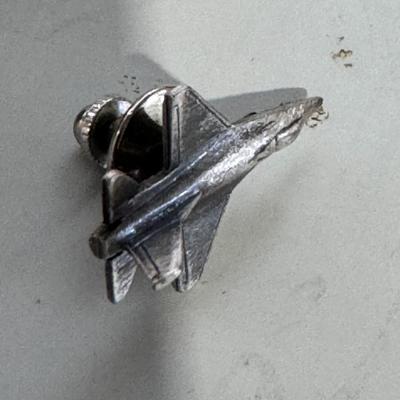
F-16 fighter jet lapel pin, also known as a stick pin or tie tack. Here's some information about this type of item: Design: It features a detailed representation of the F-16 Fighting Falcon, a prominent military aircraft, often made of silver-toned metal or pewter. Purpose: These pins are primarily used as accessories on lapels, hats, vests, or other attire to show support for the US Air Force, aviation, or as a collectible item. 692 / 1369 -
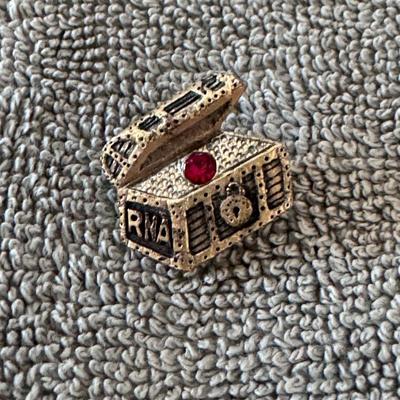
vintage Royal Navy Association (RNA) pin. Here's more information about this item: Design: The pin is shaped like a treasure chest, with the letters "RNA" clearly visible on the front. It features a red gemstone prominently placed on the lid of the chest. Purpose: This type of pin would have been worn by members of the Royal Navy Association, a non-profit organization that supports serving and retired naval personnel and their families. Era: Given the "vintage" description in search results, this pin likely dates from an earlier period, though a specific year range isn't provided. Features: It typically includes a needle pin back for attachment to clothing. 693 / 1369 -
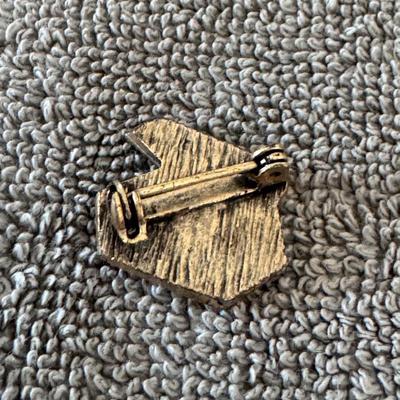
vintage Royal Navy Association (RNA) pin. Here's more information about this item: Design: The pin is shaped like a treasure chest, with the letters "RNA" clearly visible on the front. It features a red gemstone prominently placed on the lid of the chest. Purpose: This type of pin would have been worn by members of the Royal Navy Association, a non-profit organization that supports serving and retired naval personnel and their families. Era: Given the "vintage" description in search results, this pin likely dates from an earlier period, though a specific year range isn't provided. Features: It typically includes a needle pin back for attachment to clothing. 694 / 1369 -
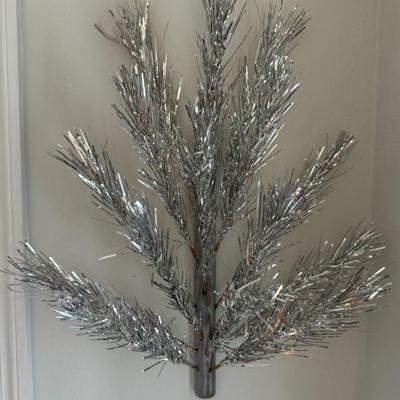
vintage "The Holiday" brand aluminum wall or door hanging Christmas tree, specifically Model K2000. Here's a summary of the item: Product: A vintage "The Holiday" aluminum Christmas tree designed to be hung on a wall or door, saving floor space. Model: K2000. Features: Branches packed in reusable storage tubes. Can be hung on any picture hook. Made from flame-proof aluminum, designed to last for years. Suitable for decorating like a full tree with lightweight ornaments. Era: These types of aluminum Christmas trees, including "The Holiday" brand, were popular during the mid-20th century, particularly in the 1950s and 60 699 / 1369 -
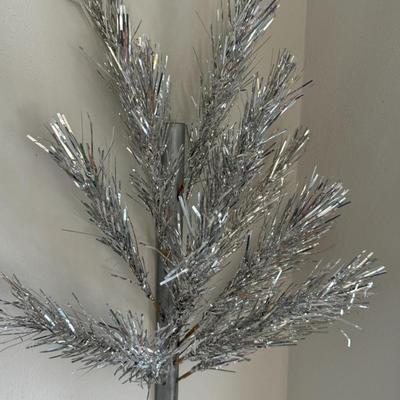
vintage "The Holiday" brand aluminum wall or door hanging Christmas tree, specifically Model K2000. Here's a summary of the item: Product: A vintage "The Holiday" aluminum Christmas tree designed to be hung on a wall or door, saving floor space. Model: K2000. Features: Branches packed in reusable storage tubes. Can be hung on any picture hook. Made from flame-proof aluminum, designed to last for years. Suitable for decorating like a full tree with lightweight ornaments. Era: These types of aluminum Christmas trees, including "The Holiday" brand, were popular during the mid-20th century, particularly in the 1950s and 60 700 / 1369
Photos 601 - 700 of 1369
Per page:
